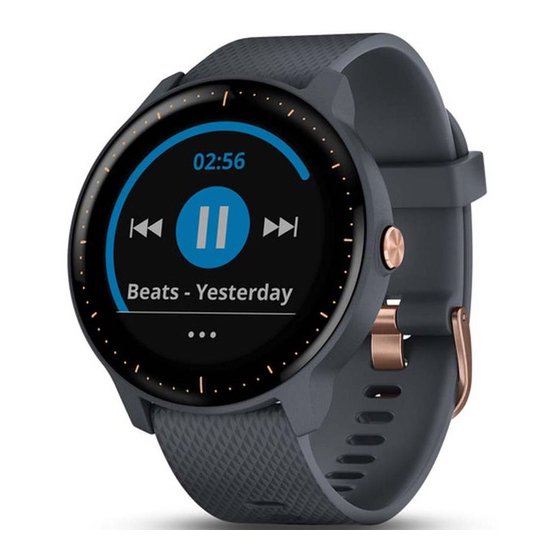Garmin VIVOACTIVE 3 MUSIC Owner's Manual - Page 10
Browse online or download pdf Owner's Manual for Watch Garmin VIVOACTIVE 3 MUSIC. Garmin VIVOACTIVE 3 MUSIC 30 pages.

NOTE: The pairing instructions differ for each Garmin
compatible device. See your owner's manual.
Turning Off the Wrist-based Heart Rate Monitor
For the vívoactive device, the default value for the Heart Rate
setting is Auto. The device automatically uses the wrist-based
heart rate monitor unless you pair a chest heart rate monitor to
the device.
NOTE: Disabling the wrist-based heart rate monitor also
disables the on-wrist detection feature for Garmin Pay
payments, and you must enter a passcode before making each
payment
(Garmin Pay
, page
™
1
Hold the touchscreen.
2
Select Settings > Sensors & Accessories > Heart Rate >
Off.
About Heart Rate Zones
Many athletes use heart rate zones to measure and increase
their cardiovascular strength and improve their level of fitness. A
heart rate zone is a set range of heartbeats per minute. The five
commonly accepted heart rate zones are numbered from 1 to 5
according to increasing intensity. Generally, heart rate zones are
calculated based on percentages of your maximum heart rate.
Setting Your Heart Rate Zones
The device uses your user profile information from the initial
setup to determine your default heart rate zones. The device
has separate heart rate zones for running and cycling. For the
most accurate calorie data during your activity, you should set
your maximum heart rate. You can also set each heart rate
zone. You can manually adjust your zones on the device or
using your Garmin Connect account.
1
Hold the touchscreen.
2
Select Settings > User Profile > Heart Rate Zones.
3
Select Default to view the default values (optional).
The default values can be applied to running and cycling.
4
Select Running or Cycling.
5
Select Preference > Set Custom.
6
Select Max. HR, and enter your maximum heart rate.
7
Select a zone, and enter a value for each zone.
Heart Rate Zone Calculations
Zone % of
Perceived Exertion
Maximum
Heart Rate
1
50–60%
Relaxed, easy pace,
rhythmic breathing
2
60–70%
Comfortable pace,
slightly deeper
breathing, conversation
possible
3
70–80%
Moderate pace, more
difficult to hold
conversation
4
80–90%
Fast pace and a bit
uncomfortable, breathing
forceful
5
90–100%
Sprinting pace,
unsustainable for long
period of time, labored
breathing
About VO2 Max. Estimates
VO2 max. is the maximum volume of oxygen (in milliliters) you
can consume per minute per kilogram of body weight at your
maximum performance. In simple terms, VO2 max. is an
6
3).
Benefits
Beginning-level
aerobic training,
reduces stress
Basic cardiovascular
training, good
recovery pace
Improved aerobic
capacity, optimal
cardiovascular training
Improved anaerobic
capacity and
threshold, improved
speed
Anaerobic and
muscular endurance,
increased power
indication of athletic performance and should increase as your
level of fitness improves.
On the device, your VO2 max. estimate appears as a number
and description. On your Garmin Connect account, you can view
additional details about your VO2 max. estimate, including your
fitness age. Your fitness age gives you an idea of how your
fitness compares with a person of the same gender and different
age. As you exercise, your fitness age can decrease over time.
VO2 max. data is provided by FirstBeat. VO2 max. analysis is
provided with permission from The Cooper Institute
information, see the appendix
page
22), and go to www.CooperInstitute.org.
Getting Your VO2 Max. Estimate
The device requires heart rate data and a timed, (up to 15
minutes) brisk walk or run to display your VO2 max. estimate.
1
Hold the touchscreen.
2
Select My Stats > VO2 Max.
If you have already recorded a brisk walk or run outdoors,
your VO2 max. estimate may appear. The device displays
the date your VO2 max. estimate was last updated. The
device updates your VO2 max. estimate each time you
complete an outdoor walk or run of 15 minutes or longer. You
can manually start a VO2 max. test to get an updated
estimate.
3
To start a VO2 max. test, swipe up, and select Test Now.
4
Follow the on-screen instructions to get your VO2 max.
estimate.
A message appears when the test is complete.
Activity Tracking
The activity tracking feature records your daily step count,
distance traveled, intensity minutes, floors climbed, calories
burned, and sleep statistics for each recorded day. Your calories
burned includes your base metabolism plus activity calories.
The number of steps taken during the day appears on the steps
widget. The step count is updated periodically.
For more information about activity tracking and fitness metric
accuracy, go to garmin.com/ataccuracy.
Auto Goal
Your device creates a daily step goal automatically, based on
your previous activity levels. As you move during the day, the
device shows your progress toward your daily goal
If you choose not to use the auto goal feature, you can set a
personalized step goal on your Garmin Connect account.
Using the Move Alert
Sitting for prolonged periods of time can trigger undesirable
metabolic state changes. The move alert reminds you to keep
moving. After one hour of inactivity, Move! and the red bar
appear. Additional segments appear after every 15 minutes of
inactivity. The device also vibrates if vibration is turned on
(System Settings, page
16).
Go for a short walk (at least a couple of minutes) to reset the
move alert.
. For more
®
(VO2 Max. Standard Ratings,
.
À
Activity Tracking
